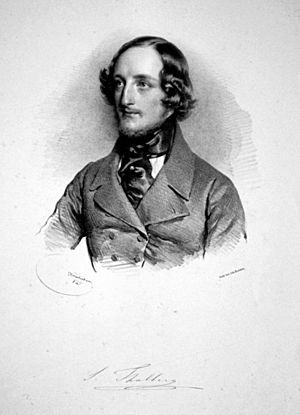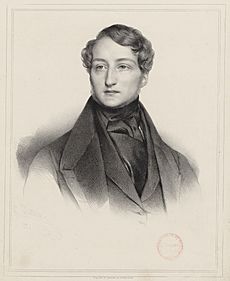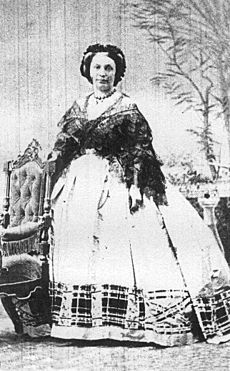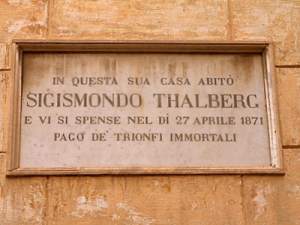Sigismond Thalberg facts for kids
Quick facts for kids
Sigismond Thalberg
|
|
|---|---|

Lithograph by Josef Kriehuber, 1841
|
|
| Born | 8 January 1812 Pâquis, Switzerland
|
| Died | 27 April 1871 |
| Occupation |
|
Sigismond Thalberg (born January 8, 1812 – died April 27, 1871) was an Austrian composer and one of the most amazing virtuoso pianists of the 19th century. He was known for his incredible skill and unique playing style.
Contents
Early Life and Musical Training
Thalberg was born in Pâquis, a place near Geneva, on January 8, 1812. Not much is known about his very early childhood. His birth certificate shows his parents were Joseph Thalberg and Fortunée Stein, both from Frankfurt-am-Main.
When he was about 10 years old, Thalberg might have moved to Vienna. He later said he attended the first performance of Beethoven's famous 9th Symphony in 1824.
His mother, Baroness von Wetzlar, was a very good amateur pianist. She might have given him his first piano lessons.
In 1826, Thalberg studied with Ignaz Moscheles in London. Moscheles felt that Thalberg was already so good that he didn't need much more help to become a great artist. Thalberg gave his first public concert in London on May 17, 1826. He then performed regularly in Vienna, playing classical pieces by composers like Hummel and Beethoven. He also played chamber music, which is music for small groups of instruments.
In 1827, his first musical work, a fantasy and variations based on melodies from Carl Maria von Weber's Euryanthe, was published.
In 1830, Thalberg met other famous composers like Felix Mendelssohn and Frédéric Chopin in Vienna. They were very impressed by his amazing technical skills on the piano. A young Clara Wieck, who was 10 at the time, heard him play in Leipzig. She wrote in her diary that his playing was "very accomplished," clear, precise, strong, and expressive.
Thalberg also studied counterpoint, which is a way of writing music where different melodies are played at the same time. This helped him include complex parts, like fugues, in his own compositions. One of his popular pieces was Grande fantaisie et variations sur 'Norma', published in 1834. Later, he changed his style, making his music less complex but still very beautiful.
Becoming a Piano Star
In November 1835, Thalberg arrived in Paris, a major center for music. He performed at private concerts and quickly became very popular. Famous artists like Gioachino Rossini and Giacomo Meyerbeer praised him.
His first solo concert in Paris on April 16, 1836, was a huge success. He earned a lot of money from it, more than any other musician had made from a single concert before.
Another famous pianist, Franz Liszt, heard about Thalberg's success. A friendly rivalry began between them. In March 1837, both Liszt and Thalberg played at a special concert to help Italian refugees.
Thalberg's fame grew even more in the following years. His Fantasia on Rossini's 'Moses', Op. 33, became one of the most famous piano pieces of the 19th century. Even Hector Berlioz, a well-known composer, praised it years later.
Traveling Across Europe
Early Tours and Acclaim
After his time in London in 1837, Thalberg went on a short tour in Great Britain. He then returned to Vienna. In 1838, he performed in Paris again, and people started calling him "the most famous of our composers."
Thalberg met Robert Schumann, another important composer, in October 1838. Schumann was amazed by Thalberg's playing. He could play difficult pieces by Chopin and Beethoven from memory. Schumann wrote in a review, "He is a God when sitting at the piano."
First Big European Tour
After his concerts in Vienna, Thalberg started his first long tour across Europe. He performed in Dresden and Leipzig, where Mendelssohn became his friend and admirer. Mendelssohn wrote to his sister, Fanny, saying wonderful things about Thalberg's playing.
Thalberg then traveled to Berlin, Danzig, St. Petersburg, and London, always receiving great reviews. He also performed with his friend, the violinist Charles de Bériot, in Brussels and the Rhineland.
A Break and New Music
Thalberg took a break from performing in 1840. He spent time relaxing and composing new music. During this time, he wrote important pieces like his Grande fantaisie sur la Sérénade et le Menuet de 'Don Juan, Op. 42, and his Fantasia on Rossini's 'Semiramide, Op. 51.
In 1841, he visited Mendelssohn and Schumann in Leipzig again. Schumann gave another enthusiastic review of his concert there. Thalberg was seen as Liszt's only real rival in the piano world.
More Triumphs in Europe
From 1841 to 1842, Thalberg gave concerts in Italy. He then returned to Paris, where his concerts were incredibly successful. Berlioz reported that Thalberg earned huge amounts of money from his performances. At one concert, a golden crown was even thrown onto the stage!
Thalberg continued to tour, visiting London and Vienna. In 1842, he received the Cross of the French Legion of Honour, a very important award. He also taught piano to selected students at the Paris Conservatoire.
In 1848, Liszt and Thalberg met again in Vienna. Liszt attended Thalberg's concert and applauded loudly, showing respect for his rival's playing.
Concerts in America
In 1843, Thalberg married Francesca ("Cecchina") Lablache, whose father was a famous opera singer. They lived in Italy for a while.
After his operas didn't do very well, Thalberg decided to tour America in 1855. He had huge success in Rio de Janeiro and Buenos Aires. He then returned to Europe briefly before heading to North America in October 1856.
In New York, Thalberg began a marathon of concerts, sometimes playing five or six days a week, and even two or three times a day! He often played pieces based on religious themes, like his Moses fantasy, which was allowed on Sundays.
His first American tour ended in July 1857. He started a second tour in September 1857, performing until June 1858. During these two seasons, he visited almost 80 cities and gave over 320 concerts in the United States and 20 in Canada. He also gave many free concerts for schoolchildren.
Thalberg earned a lot of money from these tours, possibly over $150,000, which would be millions today. People liked him because he was humble and didn't use flashy tricks. He simply gave amazing performances of his own music, which was already well-known in America. He played classical works by Beethoven, J. S. Bach, Chopin, and Mendelssohn.
His tours ended suddenly in June 1858. His wife, Francesca, had arrived from Europe, and Thalberg quickly returned with her.
Later Years and Legacy
After returning to Europe, Thalberg settled in Naples, Italy. He lived there quietly for about four years.
In 1862, he gave concerts in Paris and London again, and they were still very successful. After a final tour in Brazil in 1863, he stopped performing professionally. He considered becoming a piano professor in Naples but couldn't because he wasn't Italian.
When Thalberg passed away on April 27, 1871, he left behind a large collection of original music writings (autographs) by famous composers like J. S. Bach, Handel, Mozart, Haydn, Beethoven, and Schubert. This collection was sold after his death. He is buried in Naples' Poggioreale cemetery.
Thalberg's Composing Style
In the 1830s and 1840s, Thalberg's unique piano playing style was very influential in Europe. Many other pianists tried to copy him.
Thalberg was especially famous for his "three-hand effect" technique. This made it sound like he was playing with three hands instead of two. He achieved this by playing a melody in the middle of the piano, while his other fingers played arpeggios (broken chords) above and below it. This created a rich, full sound that amazed audiences.
Unfortunately, by the late 1800s, Thalberg was often only remembered for this one technique. His other musical ideas and innovations were sometimes forgotten.
Discography
- Grand Concerto pour le piano avec Accompagnement de l’Orchestre, f-minor, op. 5. (Francesco Nicolosi, Razumowsky Symphony Orchestra, A. Mogrelia, NAXOS 8.553701)
- 12 Etudes op. 26, Fantasie op. 33, Fantasie op. 40 (Stefan Irmer, MDG 2009)
- Fantasies on Operas by Bellini opp. 12, 10, 49, 9 (Nicolosi, NAXOS 8.555498)
- Fantasies on Operas by Verdi, Rossini and Bellini opp. 3, 70, 77, 78, 81, 82 (Nicolosi, MARCO POLO 8.223367)
- Fantasies on Operas by Donizetti opp. 68, 67, 50, 44, 66 (Nicolosi, MARCO POLO 8.223365)
- Fantasies on Operas by Rossini opp. 51, 40, 63, 33 (Nicolosi, NAXOS 8.555501)
- Soirees de Pausilippe opp. 75 (Nicolosi, MARCO POLO 8.223807)
- Lacrimosa, Fantasie on Don Giovanni (Cyprien Katsaris, Klavier, SONY SK 52551)
- Apotheose & Fantasies on French Operas (Mark Viner, Piano Classics, PCL10178)
- Opera Fantasies (Viner, Piano Classics, PCL0092)
Images for kids
See also
 In Spanish: Sigismund Thalberg para niños
In Spanish: Sigismund Thalberg para niños







